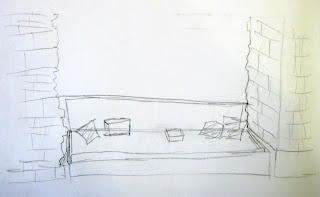Craft: Craft is something that is an art and requires a special skill. Clean lines and datum lines require special skill, as it is an art of perfection. After visiting Falling Water and Monticello, I realized they both are very highly crafted with the woodwork and masonry. Each place took special craft in how the materials were to be placed in the landscape surrounding the houses. In the hotel we stayed in over our trip, they had wooden rocking chairs in each room that were made by the Amish. The chairs are well crafted because they are handcrafted and that requires a special skill that many do not know how to do. As Roth says, “The architects become deluged with information regarding the accuracy of details.” (Roth, 472) Details are very important when it comes to good craft.

Public/Private: When you are designing a house, you don’t want every space you design to be just public, because then you wouldn’t have any place to go and have your own privacy. You have to balance out the two in a home. In Monticello, the parlor and foyer were very public places and the bedrooms and study were very private areas in the house. In Falling Water, Wright made the hallways dark and the rooms light because he felt that the hallways were not important since they are not a place to be sociable in and instead a place to get from one area to another. Even certain materials that are used in a room can tell what rooms are more private or public because Blakemore says that. “Wood, the least expensive, was the most common material for modest homes and for less important rooms in the houses of the wealthy.” (Blakemore, 400)
This is a public area in the family room at Falling Water.
Technique: Technique is a way of accomplishing a certain task. It requires a specific skill of procedures to get to the final craft. It is so amazing how they could of built Falling Water right over the waterfall. In order to make the house cantilever over the water, it had builders make logs to hold up the structure as they built it so it wouldn’t collapse. This took great technique in figuring out how to make Falling Water cantilever over the water. During the 19th century, “Inlay became a prominent decorative technique of great technical superiority…” (Blakemore, 382) Inlay used native woods just like Falling Water used its natural surroundings.

Language: When you think of the word language, you think of a foreign language that is used in communicating with others verbally. When you talk about architecture having language, it means that the structure speaks words of its own to describe it. Ludwig Mies van der Rohe once said that, “God is in the details” meaning that perfection in details has its own language and speaks something that is so unique. Both Monticello and Falling Water worked with the landscapes in a way that celebrated them. Monticello used clay for bricks and you see lots of clay color in the lot it sits in. Falling Water used stone in constructing the house, as there were lots of rock and stone in the landscape it surrounded.
Virtual: Virtual is an interesting word as I was surprised what it actually meant when I looked it up. Virtual is the existence of something without actually being there. We got to have a virtual tour of both Monticello and Falling Water, but most importantly, both houses utilized virtuality through light. Monticello used skylights that made the light come through and make you feel like virtually the sky is actually there. Mirrors in the bedrooms made the rooms virtually look bigger because the image reflects back making the space appear to be larger than it actually is. Falling Water used glass windows that didn’t have any corner support so that when you opened the corner windows, you got a virtual sense of the outside when you were inside. That made it feel like the outdoors were coming indoors. Glass was a very expensive material during the times that Falling Water and Monticello were both being built. “Around the mid-19th century a number of factors combined to make it feasible to install larger panes of window glass- manufacturing processes, excise duty, and window tax.” (Blakemore, 397) It was nice to be able to install bigger pieces of glass because glass was a way to make a room look virtually appealing since you felt part of the outdoors inside.

Summary: Craft and Technique have their own language because they make private and public spaces look virtually appealing. The way a building is put into place and the small details are put into private and public spaces. Windows and mirrors inside a house create a virtually appealing space by making the outdoors look like they are indoors and at the same time not making it distract from the room but make it celebrated.


No comments:
Post a Comment